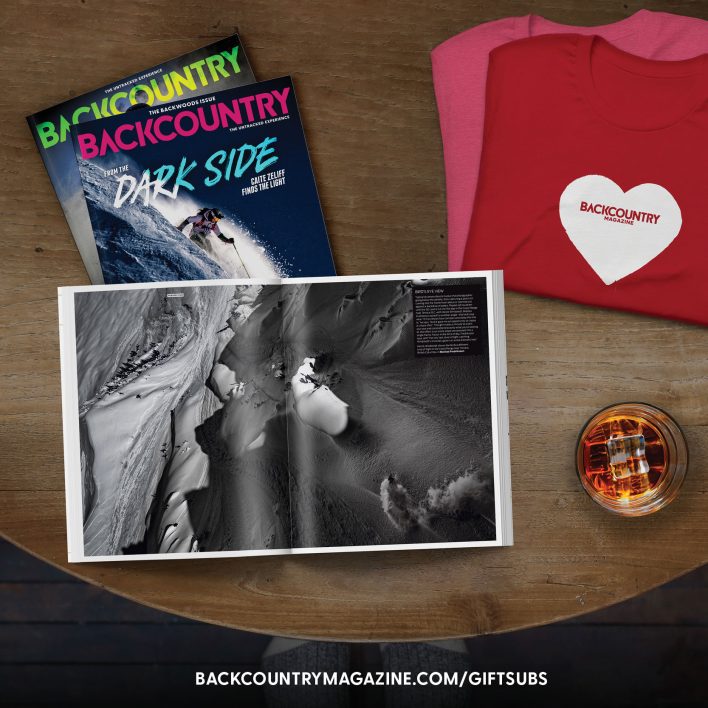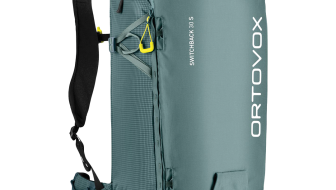“Hey. Great to hear from you. I’m out skiing—with partners—and I’m about to drop into a couloir. I’ll call you tomorrow!” With that, Forrest McCarthy, an Exum Mountain Guide who’s guided from the Canadian Rockies to Antarctica, hung up the phone, cutting off his windblown words.
A few days later, we reconnected about the value of skiing en masse, whether with just one other person or a crew of likeminded friends. “A good ski partner is like a really good long-term relationship,” McCarthy said. “I often start with shorter trips, getting to know each other. Compatibility is really important.” Trusted partners add life-saving value to a tour, from additional eyes looking for instability to providing wisecracks and nips of whiskey. And while it’s essential to make sure your partner is attuned to you and the mountains, relationships go both ways. Here’s a list of tips and suggestions to help you uphold safety and stoke within your group on your next tour.
![Setting the bootpack is one surefire way to earn your partner's respect. Frederick Reimers leads the charge in Montana's Beartooth Mountains. {Photo] Tyler Cohen](http://backcountrymagazine.com/wp-content/uploads/2015/04/betterpartner1.jpg)
Setting the bootpack is one surefire way to earn your partner’s respect. Frederick Reimers leads the charge in Montana’s Beartooth Mountains. [Photo] Tyler Cohen
Do Your Homework
Have you taken an avalanche and first-aid course, and have you recently practiced those skills?
To become a reliable ski partner, it’s imperative to build an educational foundation to know how to assess hazards and provide assistance should anything go wrong. Take an avy course and learn up on wilderness first-aid protocol. That way, you will be “prepared, equipped, educated, experienced and practiced,” says Ben Pritchett, Program Coordinator at the American Institute for Avalanche Research and Education (AIARE).
Come Prepared
Have you looked at the forecast and avy bulletin? Do you have the necessary gear and is it in order?
You can’t be a responsible partner unless you’re responsible for yourself. So do your homework, check the forecast and dial in your gear before showing up at the trailhead. “On bigger trips, we totally dork out and have spreadsheets,” says Luc Mehl, a five-time winner of the Alaska Mountain Wilderness Ski Classic, a 100- to 150-mile backcountry race. “Everybody’s got a list of group responsibilities.” Those responsibilities can vary, including tasks like bringing the ski repair kit to scheduling a food drop. Logistics are important even on day trips. At the trailhead, tell your partners what you’re carrying (i.e. “I’ve got a first-aid kit”) and don’t be bashful about asking if everyone brought their skins, especially if your day begins with a descent.
Make A Plan
What are your goals for the tour?
You’re at the trailhead and ready to go. What’s next? Discuss your plan and goals, and, based on the avy report, determine no-go terrain that you’ll avoid throughout the day. “I’ve been in situations were we’ve headed off in different directions,” McCarthy says. “You don’t know where that person is, maybe they’re injured still up the slope, maybe they’re already headed down below you or waiting at the car. That can be a real difficult situation.” Luckily, this type of confusion can be easily avoided. Devote some time the night before, in the car or at the trailhead to determine your route, meeting points and what you hope to accomplish. Revisit your plan and adapt throughout the day.
Speak Up
Are you comfortable communicating with your ski group? And are your partners comfortable with you?
Ben Pritchett has a list of ski-partner attributes that echoes McCarthy’s long-term-relationship ethos. Partner must be “willing to adjust day-to-day desires based on conditions, a good communicator, open minded and embraces others’ perspectives.” And Pritchett has a point: voicing your concerns can be the determinant for safely returning home. To ensure that your group does, McCarthy recommends, “If one person in your group feels something isn’t safe, then you don’t ski it. You ski something else that everyone is comfortable with.” The lowest common denominator always wins.
![This way to the volcan. Michi Buechers and Martin Volken navigate near Nevados de Chillan, Chile. [Photo] Tyler Cohen](http://backcountrymagazine.com/wp-content/uploads/2015/04/betterpartner_feature.jpg)
This way to the volcan. Michi Buechers and Martin Volken navigate near Nevados de Chillan, Chile. [Photo] Tyler Cohen
Right on Pace
Do you and your partner tour at the same speed? Have similar skill levels?
Pay attention to your pacing. Does it take you 20 minutes to reach a ridgeline while your partner is slogging behind in your skintrack? Or do you always seem to be out of breath and stressed to keep up? The value of an equally paced partner extends beyond sucking wind. “We’ve run into trouble where the front person’s risk assessment wasn’t the same as somebody behind them,” Mehl says of his crew. “But there wasn’t a spot to discuss because we’d spread out.” An easy solution: find some ski buddies who move at your pace, and stop and regroup at safe zones and at regular intervals.
Know Your Risk Level
How does your risk acceptance compare to your partner’s?
On average, the U.S. sees about 25 avalanche-related deaths every year. And although each scenario is unique, in each case, there was some level of assumed risk. “Risk is a very personal thing,” McCarthy says. “You want to be out with people who have similar take on risk as you do.” Instead of entering dangerous zones, a good ski partner “values managing risk according to exposure and consequence,” Pritchett adds. Start conversations with your partners about what may happen as a result of your actions and come up with strategies to reduce risk.
Managing Group Dynamics
What is the right group size for your tour? How well does your group get along?
“On my last big trip [a 260-plus-mile, month-long expedition in Alaska’s Aleutian Range] we had nine people, which is unheard of,” Mehl says. “I told that to this older mountain guy who was like, ‘Goddamn, we had five people on a trip to Denali and almost killed each other.’” Group size is hugely important to a successful tour, and with many people, come many opinions about risk and decisions. Mehl notes, “As soon as you get a larger group, you make more mistakes.” If you do head out with more than about seven individuals, consider breaking up into self-sufficient groups for the day and then reconvening at the hut or for lunch.
Humor Me
Use humor to cut the tension
Things can go wrong on a ski tour, and they often do: someone forgets his or her skins, a whiteout rolls in or the coverage just plain sucks. “When conditions are bad, you can chose to get frustrated, but that doesn’t change the conditions,” Mehl says. “Or you can chose to make a joke of it.” Cut the tension with humor and channel your inner sarcasm. After all, it’s just skiing.
![Discussing a day's tour over boxed wine and bourbon at Beartooth Powder Guides' Woody Creek Cabin. Beartooth Mountains, Mont. [Photo] Tyler Cohen](http://backcountrymagazine.com/wp-content/uploads/2015/04/betterpartner2.jpg)
Discussing a day’s tour over boxed wine and bourbon at Beartooth Powder Guides’ Woody Creek Cabin. Beartooth Mountains, Mont. [Photo] Tyler Cohen
Kick Back and Recap
What was successful about your trip? What went wrong?
After returning from a long tour, crack open a cold one and dive into what happened that day, especially if something went wrong, but even if everything went right. You and your partners can bring that day’s experience into future trips. Some observations that may seem elementary or routine can show insight into group dynamics or highlight skills to improve upon. And in sharing that knowledge, you’ll become a better ski partner the next time you head out.
—
This story first appeared in the February 2015 issue. To read more stories like it, subscribe here.










What are skins?
They’re tools used for ascending—tacky on one side to adhere to the bottom of skis and like a carpet on the other, so they can grip the snow for traction.
Here are a handful of skins that we reviewed several years back to help you get the gist, but you can also find reviews of new skins in our Gear Guide and our Deep Winter issue, out soon.